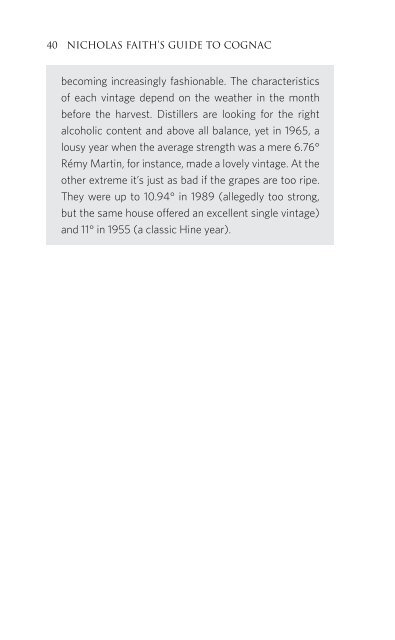Create successful ePaper yourself
Turn your PDF publications into a flip-book with our unique Google optimized e-Paper software.
ecoming increasingly fashionable. The characteristics<br />
of each vintage depend on the weather in the month<br />
before the harvest. Distillers are looking for the right<br />
alcoholic content and above all balance, yet in 1965, a<br />
lousy year when the average strength was a mere 6.76°<br />
Rémy Martin, for instance, made a lovely vintage. At the<br />
other extreme it’s just as bad if the grapes are too ripe.<br />
They were up to 10.94° in 1989 (allegedly too strong,<br />
but the same house offered an excellent single vintage)<br />
and 11° in 1955 (a classic Hine year).<br />
2<br />
THE PERSONALITY<br />
OF COGNAC<br />
Between the distiller and the drinker comes the blender.<br />
Most of the blends will be unremarkable, and most of the<br />
merchants – there are still over two hundred of them –<br />
resemble their eighteenth-century predecessors: they are<br />
largely brokers, intermediaries between the growers and<br />
buyers. Their stocks are largely ‘tactical’, held for a few years,<br />
relying on growers – and wholesalers like the Tesserons – for<br />
most of the older brandies they require. Only a handful are<br />
big enough to hold a balanced stock extending back through<br />
the decades. Nevertheless, like great craftsmen the world<br />
over, the blenders – called chef de caves or maîtres de chai<br />
– have a clear idea in their heads and in the sample of old<br />
bottles in their tasting rooms, rather than on paper, of the<br />
essential qualities historically associated with their name. For<br />
the role of the blender is so key that it became an hereditary<br />
occupation. Until very recently generations of Fillioux were


